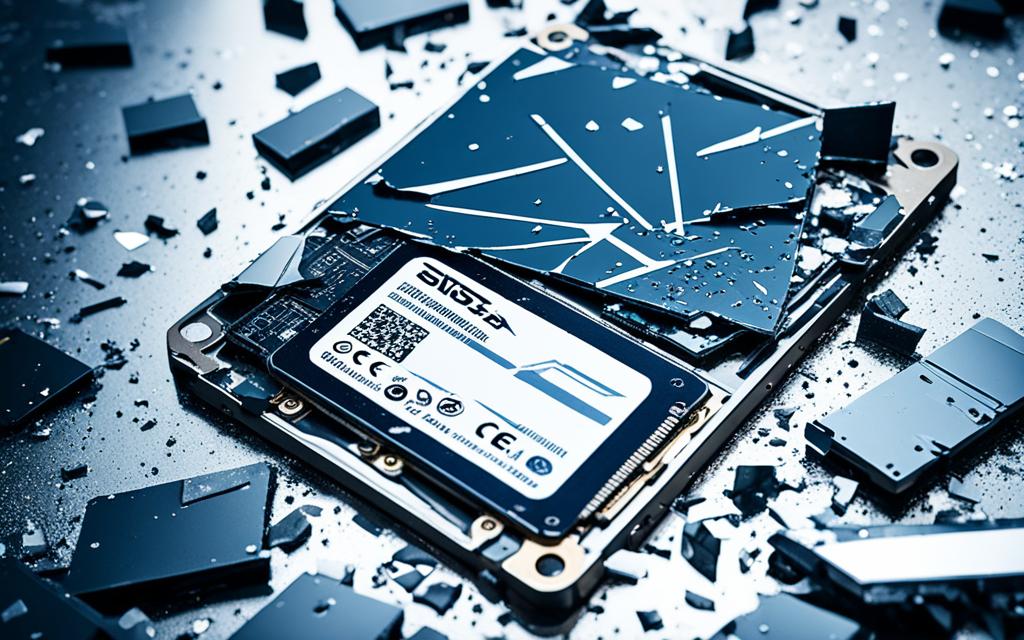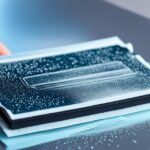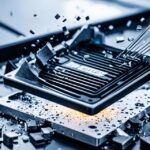Table of Contents
In our digital age, keeping data safe even after deleting it is key. For SSDs, just hitting ‘delete’ doesn’t cut it. The tech inside SSDs saves data differently, making it tricky to fully erase. Knowing how to properly trash an SSD is crucial to keep your private info safe. We’ll look at how to get rid of data for good, covering both smashing the SSD and using software that wipes data clean.
Key Takeaways
- Simply erasing files won’t work for SSD disposal.
- You can destroy them physically or with special software.
- Using the right approach ensures no data gets left behind.
- Knowing the best practices helps in secure data tossing.
- It’s wise to seek professional advice for destroying data properly.
Understanding SSDs and Their Data Storage Mechanism
SSDs have changed the way we store data, offering a big leap from HDDs. SSDs work differently as they don’t have moving parts. Instead, they use flash memory for faster access and retrieval. This makes them speedy and changes how we delete data on them.
What Makes SSDs Different from HDDs?
SSDs stand out because they’re faster and more reliable than HDDs. They don’t have moving parts, which means they can access files quickly. SSDs keep data on chips, which makes old deletion methods useless1. Also, SSDs spread out data to avoid wearing out, making it hard to erase data fully with software1.
The Role of NAND Flash Memory in Data Storage
NAND flash memory is key to SSDs, allowing them to quickly retrieve data and be more durable. SSDs aren’t affected by magnets like HDDs, making them great for carrying around2. But, wiping data off an SSD is tough. Standard erasure tools don’t always work, possibly leaving data behind2.
It’s important to fully destroy SSD data to keep info safe and meet data protection laws. Tools like the Crunch 250 ensure data on SSDs is gone for good21.
Why Simply Deleting Files is Insufficient
Deleting files from an SSD might look easy, but it’s not always effective. Just erasing files doesn’t fully remove sensitive info. This is because of data recovery challenges. SSDs use complex algorithms to spread out the wear and tear. This makes it hard to totally get rid of data.
The Challenges of Data Recovery on SSDs
Getting rid of data for good is tricky. SSDs have features that try to save deleted memory. Some have a secure erase option that you can start from a bootable Linux USB. Still, this might not work the same on all SSDs3. Also, trying to overwrite files with random data often misses bits. Unlike old magnetic drives, SSDs can keep data hidden even after you try to overwrite it4.
The Importance of Complete Data Erasure
To be sure you’ve wiped an SSD clean, basic deleting won’t cut it. You need advanced methods that overwrite data many times. This can help stop any leftover data from being a problem. Sometimes, you might need special software which can take about ten minutes for a 100GB space3. Or, you could physically destroy the SSD. You can drill holes in it or use acid. This makes sure no one can ever read the data again. It’s vital for industries where keeping secrets is paramount4.
How to Destroy an SSD
Destroying an SSD properly is crucial to protect private information. It stops others from accessing sensitive data once the SSD is thrown away. Using both physical methods and special software makes sure no one can get the data back.
Physical Destruction Techniques
There are strong methods to securely destroy an SSD. Special shredders can turn the SSD into tiny pieces. This method is confirmed by experts as the best way to make sure all data is completely gone5. Companies like Security Engineered Machinery and Garner make these shredders. They help safely get rid of the SSD6.
It’s particularly important for SSDs welded into computers, like recent Macs. Regular ways of throwing them away don’t work6.
Utilising Advanced Data Wiping Software
Before breaking the SSD, using data wiping software is a smart move. These programmes are made for SSDs. They clear data securely before the SSD is physically destroyed. Encrypting data on SSDs also makes it impossible to read without a special key6.
However, just overwriting files isn’t totally safe. Some bits of data might still be recovered5. So, it’s best to use both wiping software and physical destruction to ensure total safety.
Comparing SSD Destruction Methods
Different ways exist to destroy SSDs effectively. Each one has its benefits and possible downsides. Knowing these is crucial for keeping data safe.
Shredding: A Reliable Approach to Data Destruction
SSD shredding breaks memory chips into tiny, unreadable bits. The Crunch 250 by VS Security Products is a compact option for on-site shredding. It7lets organisations manage the destruction process themselves. This way, the chance of anyone recovering the data is almost zero. It also meets strict data security standards.
Incineration: Ensuring Total Data Elimination
Incinerating SSDs involves exposing them to very high heat. This method doesn’t just break the drive; it also wipes out any stored data. Done right, incineration makes sure data can’t be recovered. It’s a secure choice for handling sensitive data8.
Risks of Using Unconventional Methods
Some less common methods for destroying data can be risky. Trying to crush SSDs or just recycling them might not fully destroy the data. These approaches could lead to data theft. It’s best to stick to trustworthy methods like shredding or incineration. These protect sensitive information well.
Understanding the implications of each destruction method is key to effective data security.
Every method has its strengths. The right choice depends on what an organisation needs and has. In our modern, data-focused world, picking a suitable SSD destruction method is crucial78.
Conclusion
To sum up the main points in this article, knowing how SSDs store data is key for safe disposal. SSDs use flash memory and have no moving parts. This makes them fast and strong but hard to erase data from9. Just deleting files or formatting won’t fully remove sensitive info that could be retrieved2. It’s critical to fully wipe data to keep it secure, especially for companies with important info.
It’s very important to use proper destruction methods. Shredding or burning the SSDs makes the data impossible to get back9. Using machines like the Crunch 250 Hard Drive Destroyer ensures you follow data protection laws and keeps your data safe2.
In closing, secure SSD disposal is something we must take seriously. As technology advances, we need to update our data protection methods. This article offers steps to keep your data safe from hackers. With these tips, you can safeguard your information effectively10.
FAQ
What are the best methods to securely destroy an SSD?
To safely destroy an SSD, you can physically break it by shredding or burning it. Besides, there’s special software for SSDs that ensures all data gets completely wiped.
How do SSDs differ from traditional HDDs?
SSDs use NAND flash memory for quicker data access since they have no moving parts. In contrast, HDDs work with spinning disks. This means we handle SSDs and HDDs differently, especially when destroying data.
Why is merely deleting files from an SSD not sufficient?
Just deleting files doesn’t fully erase them due to SSDs’ special wear-leveling. This leaves some data that can be recovered. To truly get rid of data, we must use specific erasure methods.
What physical destruction methods can be used to destroy SSDs?
To destroy an SSD, you can shred it into tiny bits or incinerate it. Both ways make sure no one can ever access the data again.
Are there any unconventional methods for SSD destruction?
It’s best to avoid unusual methods like recycling or crushing for destroying SSDs. They might not work well and could leave your data at risk. Stick with proven destruction techniques to keep your information safe.
Source Links
- https://medium.com/@veritysystems/how-to-destroy-ssd-data-a67dffbd5b83 – How to destroy SSD data
- https://medium.com/@veritysystems/how-to-properly-destroy-an-ssd-6-ways-not-to-do-it-49e471af485e – How to Properly Destroy an SSD and the 6 Ways Not to Do It
- https://discussions.apple.com/thread/253418947 – How secure erase the SSD
- https://arstechnica.com/civis/threads/ask-ars-how-can-i-safely-erase-the-data-from-my-ssd-drive.1138310/ – Ask Ars: How can I safely erase the data from my SSD drive?
- https://www.semshred.com/how-to-and-how-to-not-destroy-ssds-at-end-of-life/ – How to — and How to NOT — Destroy SSDs at End-of-Life – SEM Shred
- https://www.backblaze.com/blog/how-to-securely-recycle-or-dispose-of-your-ssd/ – How to Securely Recycle or Dispose of Your SSD
- https://www.veritysystems.com/news-blog/destroy-ssd-how-is-it-done/ – Destroy SSD -How is it done? | VS Security
- https://phiston.com/hard-drives-vs-solid-state-drives-and-different-data-destruction-techniques/ – Hard Drives vs Solid State Drives and Different Data Destruction Techniques
- https://phiston.com/how-to-destroy-ssd-drives-and-does-degaussing-work-on-them/ – How to Destroy SSD Drives (And Does Degaussing Work on Them?)
- https://www.e-kom.com/Documents/Categories/611/flash-storage(8).pdf – PDF








